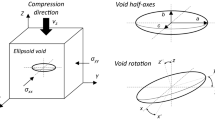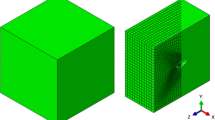Abstract
In the present research, void closure during the open die forging process of large size AISI410 martensitic stainless-steel ingots was studied using a combination of analytical modeling, finite element simulations, and experimental validations. The analytical model assumes that the voids during deformation can be represented by initially spherical geometry changing to ellipsoid or cracks before being completely closed. Finite element simulations of the open die forging were conducted using the Forge® NxT 3.1 software to simulate the stresses and strains predicted by the analytical model. Hot forging experiments were conducted on large size cylindrical samples at the center of which spherical voids simulating the presence of porosity, were machined. After hot forging, the closure levels of the voids were compared with those predicted by the model and very good agreement (discrepancy in the range of 7%) was observed. This showed that the model could be confidently used for prediction of the void closure in industrial open die forging processes.









Similar content being viewed by others
Abbreviations
- \({E}_{e}\) :
-
Effective strain
- \({H}_{i}\) :
-
Industrial ingot height
- \({H}_{e}\) :
-
Experimental sample height
- \(m\) :
-
Strain rate sensibility coefficient
- \(n\) :
-
Norton coefficient
- \({q}_{1};{q}_{2};{q}_{3};{q}_{4}\) :
-
Constants in the model by Zhang et al. [35] for voids closure
- \({S}_{f}\) :
-
Final void cross sectional area
- \({S}_{i}\) :
-
Initial void cross sectional area
- \({T}_{x}\) :
-
Stress triaxiality (the hydrostatic stress divided by the Von Mises stress)
- \({V}_{f}\) :
-
Final void volume
- \({V}_{i}\) :
-
Initial void volume
- \({\dot{\varepsilon }}_{i}\) :
-
Strain rate
- \({\sigma }_{i}\) :
-
Stress
- \({\Phi }_{i}\) :
-
Industrial ingot diameter
- \({\Phi }_{e}\) :
-
Experimental sample diameter
References
Budiansky B, Hutchinson JW, Slutsky S (1982) Void growth and collapse in viscous solids. Mech Sol 13–45. https://doi.org/10.1016/B978-0-08-025443-2.50009-4
Carroll JD, Brewer LN, Battaile CC, Boyce BL, Emery JM (2012) The effect of grain size on local deformation neara void-like stress concentration. Int J Plast 1(39):46–60. https://doi.org/10.1016/j.ijplas.2012.06.002
Chbihi A, Bouchard PO, Bernacki M, Muñoz DP (2017) Influence of Lode angle on modelling of void closure in hot metal forming processes. Finite Elem Anal Des 126:13–25. https://doi.org/10.1016/j.finel.2016.11.008
Dudra SP, Im YT (1990) Analysis of void closure in open-die forging. Int J Mach Tool Manu 30(1):65–75. https://doi.org/10.1016/0890-6955(90)90042-H
Duva JM, Hutchinson JW (1984) Constitutive potentials for dilutely voided nonlinear materials. Mech Mater 3(1):41–54. https://doi.org/10.1016/0167-6636(84)90013-9
Feng C, Cui Z, Liu M, Shang X, Sui D, Liu J (2016) Investigation on the void closure efficiency in cogging processes of the large ingot by using a 3-D void evolution model. J Mater Process Tech 237:371–385. https://doi.org/10.1016/j.jmatprotec.2016.06.030
Fleck NA, Hutchinson J (2001) A reformulation of strain gradient plasticity. J Mech Phys Solids 49(10):2245–2271. https://doi.org/10.1016/S0022-5096(01)00049-7
Gao X, Kim J (2006) Modeling of ductile fracture: significance of void coalescence. Int J Solids Struct 43(20):6277–6293. https://doi.org/10.1016/j.ijsolstr.2005.08.008
Gologanu M, Leblond JB, Devaux J (1994) Approximate models for ductile metals containing non-spherical voids-case of axisymmetric prolate ellipsoidal cavities. J Mech Phys Solids 41(11):1723–1754. https://doi.org/10.1016/0022-5096(93)90029-F
Gravier P, Mas F, Barthelemy A, Boller E, Salvo L, Lhuissier P (2022) Mechanisms and kinetics of pore closure in thick aluminum plate. J Mater Process Technol 303:117499. https://doi.org/10.1016/j.jmatprotec.2022.117499
Gurson AL (1977) Continuum theory of ductile rupture by void nucleation and growth: part I-yield criteria and flow rules for porous ductile media. J Eng Mater Technol 99(1):2–15. https://doi.org/10.1115/1.3443401
Harris N (2016) Determination of optimal forging conditions for void elimination in large steel ingots. Master Dissertation, École de Technologie supérieure. https://espace.etsmtl.ca/id/eprint/1771
Harris N, Shahriari D, Jahazi M (2016) Analysis of void closure during open die forging process of large size steel ingots. Key Eng Mater 716:579–585. https://doi.org/10.4028/www.scientific.net/KEM.716.579
Hauri J, Graf M, Awiszus B, Kawalla R (2018) Closing of shrinkage cavities by means of open-die forging. Mater Sci Forum 918:77–84. https://doi.org/10.4028/www.scientific.net/MSF.918.77
Hibbe P, Hirt G (2020) Analysis of the bond strength of voids closed by open-die forging. Int J Mater Form 13(1):117–126. https://doi.org/10.4028/www.scientific.net/MSF.918.77
Kakimoto H, Arikawa T, Takahashi Y, Tanaka T, Imaida Y (2010) Development of forging process design to close internal voids. J Mater Process Technol 210(3):415–22. https://doi.org/10.1016/j.jmatprotec.2009.09.022
Kukuryk M (2019) Experimental and FEM analysis of void closure in the hot cogging process of tool steel. Metals 9(5):538. https://doi.org/10.3390/met9050538
Landes JD, McCabe DE, Boulet JA (1994) Fracture mechanics: twenty-fourth volume. In National Symposium on Fracture Mechanics, 24th, Gatlinburg, Tennessee, USA (No. 1207). https://www.worldcat.org/title/fracture-mechanics-twenty-fourth-volume/oclc/32296916
Lu XZ, Chan LC (2018) Micro-voids quantification for damage prediction in warm forging of biocompatible alloys using 3D X-ray CT and RVE approach. J Mater Process Technol 258:116–127. https://doi.org/10.1016/j.jmatprotec.2018.03.020
Monchiet V, Cazacu O, Charkaluk E, Kondo D (2008) Macroscopic yield criteria for plastic anisotropic materials containing spheroidal voids. Int J Plast 24(7):1158–1189. https://doi.org/10.1016/j.ijplas.2007.08.008
Needleman A, Tvergaard VF (1984) An analysis of ductile rupture in notched bars. J Mech Phys Solids 32(6):461–490. https://doi.org/10.1016/0022-5096(84)90031-0
Niordson CF (2008) Void growth to coalescence in a non-local material. Eur J Mech A-Solid 27(2):222–233. https://doi.org/10.1016/j.euromechsol.2007.07.001
Niu L, Zhang Q (2022) A void closure model based on hydrostatic integration and the Lode parameter for additive manufacturing AlSi10Mg. J Manu Process 73:235–247. https://doi.org/10.1016/j.jmapro.2021.10.056
Pardoen T, Hutchinson JW (2000) An extended model for void growth and coalescence. J Mech Phys Solids 48(12):2467–512. https://doi.org/10.1016/S0022-5096(00)00019-3
Ragab AR (2004) Application of an extended void growth model with strain hardening and void shape evolution to ductile fracture under axisymmetric tension. Eng Fract Mech 71(11):1515–1534. https://doi.org/10.1016/S0013-7944(03)00216-9
Rice JR, Tracey DM (1969) On the ductile enlargement of voids in triaxial stress fields. J Mech Phys Solids 17(3):201–217. https://doi.org/10.1016/0022-5096(69)90033-7
Saby M (2013) Understanding and modeling of void closure mechanisms in hot metal forming processes. (Thesis dissertation, École Nationale Supérieure des Mines de Paris). https://pastel.archives-ouvertes.fr/pastel-00979301
Saby M, Bouchard PO, Bernacki M (2015) A geometry-dependent model for void closure in hot metal forming. Finite Elem Anal Des 105:63–78. https://doi.org/10.1016/j.finel.2015.07.003
Sun L, Liao R (2015) Mechanical analysis of RuT300 steel by using modified 3D RVE model. Advances in future manufacturing engineering, 1st edn, CRC Press
Szelążek J, Mackiewicz S, Kowalewski ZL (2009) New samples with artificial voids for ultrasonic investigation of material damage due to creep. NDT&E Int 42(2):150–156. https://doi.org/10.1016/j.ndteint.2008.11.004
Tkadlečková M, Michalek K, Gryc K, Smetana B, Machovčák P, Socha L (2013) The effect of boundary conditions of casting on the size of porosity of heavy steel ingot. J Ach Mater Manuf Eng 56(1):29–37. http://jamme.acmsse.h2.pl/papers_vol56_1/5614.pdf
Tvergaard V (1989) Material failure by void growth to coalescence. Adv Appl Mech 27:83–151. https://doi.org/10.1016/S0065-2156(08)70195-9
Wang J, Fu P, Liu H, Li D, Li Y (2012) Shrinkage porosity criteria and optimized design of a 100-ton 30Cr2Ni4MoV forging ingot. Mater Design 35:446–456. https://doi.org/10.1016/j.matdes.2011.09.056
Zapara M, Tutyshkin N, Müller WH (2013) Growth and closure of voids in metals at negative stress triaxialities. Key Eng Mater 554:1125–1132. https://doi.org/10.4028/www.scientific.net/KEM.554-557.1125
Zhang XX, Cui ZS, Chen W, Li Y (2009) A criterion for void closure in large ingots during hot forging. J Mater Process Technol 209(4):1950–1959. https://doi.org/10.1016/j.jmatprotec.2008.04.051
Acknowledgements
The authors would like to thank Finkl Steel-Sorel for funding this research study and supplying materials through Mitacs Grant No. IT16470.
Author information
Authors and Affiliations
Corresponding author
Ethics declarations
Conflict of interest
The authors declare that they have no conflict of interest.
Additional information
Publisher's note
Springer Nature remains neutral with regard to jurisdictional claims in published maps and institutional affiliations.
Rights and permissions
Springer Nature or its licensor (e.g. a society or other partner) holds exclusive rights to this article under a publishing agreement with the author(s) or other rightsholder(s); author self-archiving of the accepted manuscript version of this article is solely governed by the terms of such publishing agreement and applicable law.
About this article
Cite this article
Geisler, A., Sadeghifar, M., Morin, JB. et al. Void closure during open die forging of large size martensitic stainless-steel ingots: an experimental-analytical-numerical study. Int J Mater Form 16, 11 (2023). https://doi.org/10.1007/s12289-022-01735-y
Received:
Accepted:
Published:
DOI: https://doi.org/10.1007/s12289-022-01735-y




